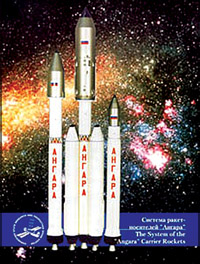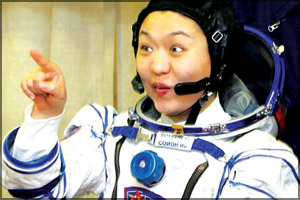 First
South Korean astronaut reaches the ISS First
South Korean astronaut reaches the ISS
With the initiatives taken by many new countries to conquer outer
space, Yi So-yeon, a 29-year-old nanotechnology engineer of South Korea
became the latest female astronaut to face the challenge by becoming the
first South Korean astronaut to travel out into space.
Her mission was to reach the International Space Station (ISS) to
conduct scientific experiments during her eleven day stay, and her
partners during the voyage were the two Russian cosmonauts, Sergei
Volkov and Oleg Kononenko. The launch took place on April 8, 2007 from
the Baikonur Cosmodrome in Kazakhstan.
 A
Soyuz TMA-12 spaceship was used in this mission, and the Russian space
rocket had successfully reached the ISS and docked with the orbiting
platform on April 10, 2007. South Korea had paid Russia about 25 million
dollars to send its first national into space. A
Soyuz TMA-12 spaceship was used in this mission, and the Russian space
rocket had successfully reached the ISS and docked with the orbiting
platform on April 10, 2007. South Korea had paid Russia about 25 million
dollars to send its first national into space.
This historical event has many fascinating facts behind it as well.
Most importantly, the Soyuz TMA-12 was lifted off from the world’s
oldest space launch pad, used by Russia’s Yuri Gagarin when he became
the first human in space in 1961. Furthermore, being the first South
Korean in space, So-yeon also became the 49th female astronaut of all
time.
Sergei Volkov who was a partner of Yi So-yeon is former astronaut
Alexander Volkov’s son and so this event goes into history also as the
first space dynasty.
How Yi So-yeon got the opportunity to be the first astronaut for
South Korea is also interesting. She has been a reserve candidate, and
had been picked for the flight in March after Ko San, who was to be the
primary astronaut, was charged by Russia for removing important
documents from a training centre.
Yi returned to Earth on April 19 while her travel partners Russian
Commander Volkov and flight engineer Oleg Kononenko stayed on for a
period of six months in orbit. On this return flight, she was
accompanied by another special person, Peggy Whitson who has been the
commanding officer of the ISS.
She also made history by achieving the longest total time in space,
of 377 days on two missions. She also holds the women’s world record for
the most spacewalking time, which amounts to 39 hours and 46 minutes in
total.
A new launch vehicle from Russia
 A
whole fleet of launch vehicles are used by Russia, USA and other
countries which are into space exploration to shoot payloads out into
space. A
whole fleet of launch vehicles are used by Russia, USA and other
countries which are into space exploration to shoot payloads out into
space.
However, one important shortcoming with these rockets is that they
cannot carry very heavy loads, and as a result, sometimes missions are
made small and it causes multiple space travels to take place. Russia
has come up with a solution for this.
The Angara rocket, currently under development, is designed to put
heavy payloads into orbit. This kind of rockets will be available in a
range of configurations capable of lifting between two and 24.5 metric
tons to low-Earth orbit.
Flight tests of this new-generation Russian space launch vehicle will
start in 2010. It is mainly planned for launch from the Plesetsk space
center, located in northwest Russia.
The Angara will be used to put satellites into orbit as part of the
Federal Space Program, as well as joint international space projects.
The space centre is also planning to develop a new super-heavy-lift
rocket capable of putting into orbit payloads of between 45 and 175
tons.
Outer space assembly by Russia
 Requirements
related to space travel are changing daily, and the necessity to carry
larger payloads has become a key concern. The Angara rocket is going to
be one solution as mentioned earlier in today’s edition. However, Russia
has taken a further step and is going to create a manned assembly
complex in orbit. Requirements
related to space travel are changing daily, and the necessity to carry
larger payloads has become a key concern. The Angara rocket is going to
be one solution as mentioned earlier in today’s edition. However, Russia
has taken a further step and is going to create a manned assembly
complex in orbit.
This assembly complex is to be used to make dockings in orbit, build
craft there and send them to the Moon, Mars and other planets. The
intention of this is to get rid of the massive energy and power required
in launches from Earth due to gravity and other resistances.
The main reason behind this scheme is because the new generation
piloted spacecraft is believed to weigh 18-22 tones, and it will be
impossible to launch it with the available rockets. With all the
modifications, the Soyuz can carry no more than 16-17 tones, so it will
be impossible to use it for the purposes.
Furthermore, this new concept will be a solution to the fact that
Russia doesn’t have engines so far for rockets to carry spacecraft not
only to orbits around the Earth, but also to other planets.
- Aravinda Dassanayake |
